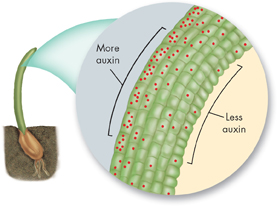How Hormones Act Cells in an organism affected by a particular hormone are called target cells. To respond to a hormone, a cell must contain hormone receptors—usually proteins—to which hormone molecules bind. The response that results will depend on what kinds of receptors are present in the target cell. One kind of receptor might alter metabolism; a second might speed growth; a third might inhibit cell division. Thus, depending on the receptors present, a given hormone may affect roots differently from stems or flowers—and the effects may change as the developing organs add or remove receptors. Cells that do not contain receptors are generally unaffected by hormones.

FIGURE 24–13 How Plants Detect Light The Darwins conducted controlled experiments to determine which region of the plant senses light. When they removed the seedling tip or placed an opaque cap over the tip, they observed no bending toward light. But when they placed a clear cap on the tip or an opaque shield around the base, they observed bending similar to that seen in the control. Control Variables What variable did the Darwins control for by comparing the results of seedlings treated with a clear cap versus no cap?
Auxins The first step in the discovery of plant hormones came over a century ago, and was made by a scientist already familiar to you. In 1880, Charles Darwin and his son Francis published the results of a series of experiments exploring the mechanism behind a grass seedling's tendency to bend toward light as it grows.
The results of their experiments, shown in Figure 24–13, suggested that the tip of the seedling somehow senses light. The Darwins hypothesized that the tip produces a substance that regulates cell growth. More than forty years later, the regulatory substances produced by the tips of growing plants were identified and named auxins. Auxins stimulate cell elongation and the growth of new roots, among other roles that they play. They are produced in the shoot apical meristem and transported to the rest of the plant.
▸ Auxins and Cell Elongation One of the effects of auxins is to stimulate cell elongation, as shown in Figure 24–14. In the Darwins' experiment, when light hits one side of the shoot, auxins collect in the shaded part of the shoot. This change in concentration stimulates cells on the dark side to lengthen. As a result, the shoot bends away from the shaded side and toward the light.
 In Your Notebook Review Figure 24–13. Describe how the results led the Darwins to conclude that the tip of the seedling senses light.
In Your Notebook Review Figure 24–13. Describe how the results led the Darwins to conclude that the tip of the seedling senses light.

FIGURE 24–14 Auxins and Cell Elongation Cells elongate more on the shaded side of the shoot, where there is a higher concentration of auxins.
Table of Contents
- Formulas and Equations
- Applying Formulas and Equations
- Mean, Median, and Mode
- Estimation
- Using Measurements in Calculations
- Effects of Measurement Errors
- Accuracy
- Precision
- Comparing Accuracy and Precision
- Significant Figures
- Calculating With Significant Figures
- Scientific Notation
- Calculating With Scientific Notation
- Dimensional Analysis
- Applying Dimensional Analysis




